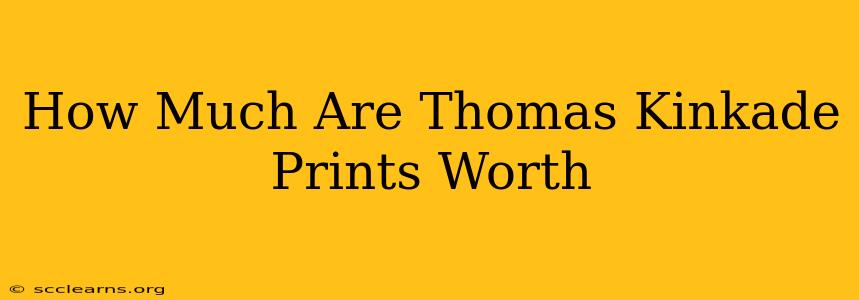Thomas Kinkade prints, known for their idyllic depictions of charming cottages and picturesque landscapes, hold a unique place in the art market. Determining their worth, however, isn't a simple matter of checking a price list. Several factors significantly influence the value of a Kinkade print, making understanding these nuances crucial for collectors and those considering selling.
Factors Affecting the Value of Thomas Kinkade Prints
Several key elements determine the value of a Thomas Kinkade print. These factors interact, creating a complex equation that affects a print's worth:
1. Rarity and Edition Size:
- Limited Editions are Key: The smaller the edition size, the more valuable the print. Highly sought-after pieces from limited editions can command significantly higher prices than mass-produced prints. Look for information on the edition number, often found on the print itself or accompanying documentation.
- Proofs and Artist's Proofs: These special prints, created before the main edition, are usually extremely rare and highly valuable to collectors. They are often numbered differently and may bear special markings.
2. Condition:
- Perfect Condition is Paramount: The condition of the print drastically impacts its value. Tears, creases, discoloration, or fading can significantly lower its worth. A pristine, unblemished print in its original frame will always fetch a higher price.
- Framing and Matting: The quality of the frame and matting also influences value. Original framing from the publisher often adds to the print's desirability.
3. Subject Matter and Popularity:
- Iconic Images are More Valuable: Certain Thomas Kinkade images are simply more popular than others. Prints depicting beloved themes, such as quaint cottages or inspirational landscapes, tend to hold higher value among collectors. Specific titles within his broader portfolio are known to be more in-demand.
- Series and Collections: Prints that are part of a specific series or collection often command a higher price than individual pieces. This is largely due to their collectibility and the desire to own a complete set.
4. Authenticity and Provenance:
- Verifying Authenticity: Ensure the print is genuine and not a counterfeit. Look for official markings, certificates of authenticity, or other documentation provided by the publisher. This is critical to establishing value.
- Provenance Matters: Knowing the history of the print—where it has been and who owned it—can add to its value, especially if it can be linked to notable collectors or significant events.
5. Market Demand:
- Fluctuations in the Market: The value of Thomas Kinkade prints, like any collectible, is subject to market fluctuations. Current demand and collector interest directly impact pricing. Online auction sites and art marketplaces can provide insights into current market trends.
- Economic Conditions: Broader economic factors can also play a role in influencing the value of collectibles, including Thomas Kinkade prints.
How to Determine the Value of Your Thomas Kinkade Print
To ascertain the value of your Thomas Kinkade print, consider these steps:
-
Identify the Print: Determine the exact title and edition number. This information is crucial for researching its value.
-
Assess the Condition: Carefully examine the print for any damage or imperfections.
-
Research Online: Consult online auction sites (eBay, etc.), art marketplaces, and collector forums to see what similar prints have sold for recently.
-
Seek Professional Appraisal: For high-value prints, consider seeking a professional appraisal from a reputable art appraiser specializing in prints and collectibles.
In conclusion, the value of a Thomas Kinkade print is a multifaceted assessment influenced by numerous variables. Careful consideration of these factors allows collectors to understand the true worth of their pieces and make informed decisions regarding buying, selling, or simply appreciating their artwork. Remember that the market is dynamic; therefore, consistent research is essential for staying up-to-date on current values.

